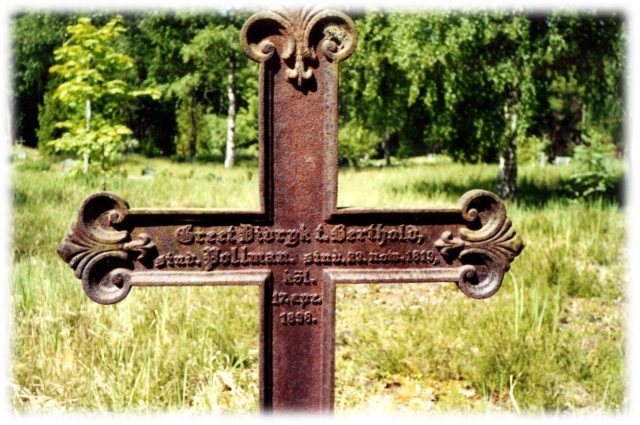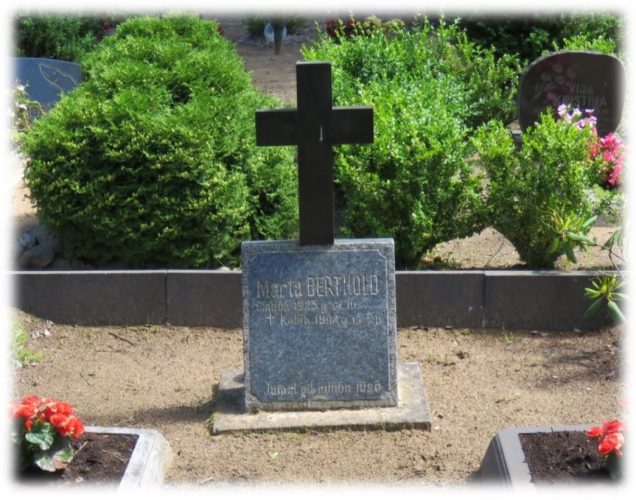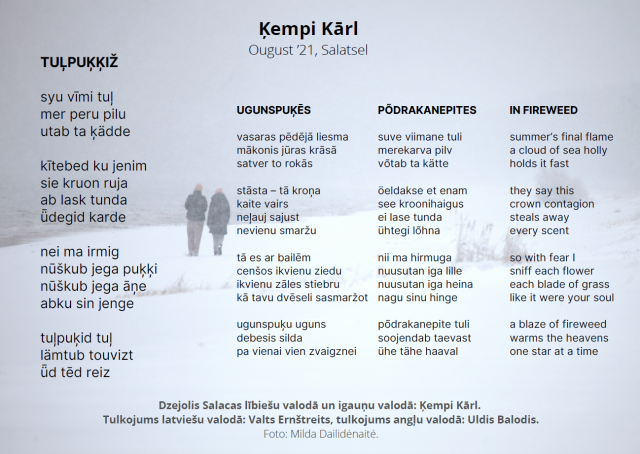
Tombstones with inscriptions in Livonian in Kolka cemetery
The oldest surviving cemetery cross with an inscription in Livonian language is in Kolka Lutheran cemetery in the North Kurzeme Livonian seaside cemeteries.
Tombstones with inscriptions in Livonian in Kolka cemetery
Latvians also call October the veļu mēnesis (the month of the souls of the dead). And that is a great reason to look at the Livonian seaside cemeteries, where most of the coastal Livonians who lived in the 19th and 20th centuries rest. However, there are very few tombstones with inscriptions in Livonian in the Livonian cemetery in North Kurzeme (Livonian: Kurāmō). Most of it is in Kolka cemetery. In the Liv language, October is Viimsi – Rainy Month.
Kolka cemetery

The oldest surviving grave cross with an inscription in Livonian says that Grieta and Andrejs Bertholds’ are resting here. On the east side of the solid iron cross is the inscription:
Greet Didrgk t. Berthold,
sind. Pollman. sind. 23. nov. 1819,
kõl. 17. apr. 1898.
Grieta Didriķa d. (daughter) Bertholde,
born Pollmane, b. Nov 23, 1819,
died Apr 17 1898

On the west side of the cross horizontally:
Andryks Anš p. Berthold
sind. 23. nov. 1816, kõl. 20. aug. 1892.
Andrejs (son of Ansis) Bertholds
born Nov 23, 1816, died Aug 20, 1892
Žonaki homestead was one of the oldest in the village of Vaide, and it was mentioned in the list of contributions in 1736. Bērtulis became the owner of Žonaki in 1789. In 1834 he took the surname Bertholds for himself and his sons.
During the Livonian uprising, in 1860, the management of Žonaki was already in the hands of Bērtulis’ grandson Andrejs Bertholds and his wife Grieta, the sister of the Livonian teacher and Kolka’s verger Niks Polmanis. From the family of eighteen children only eight survived to grow old. The Bertholds’ family was widely branched, thanks to the large group of children of Bērtulis’ son Ansis Bertholds (1793) and, even more so, the descendants of Berthold’s grandson Andrejs Bertholds (1816). In this vast and strong Livonian family grew several important people and bright personalities in the cultural history of the Livonians, who did not disappear in the distant ways of the world.

Ģēde Štālere’s tombstone in Kolka Orthodox cemetery.
Täs Kuolka kalmatarās igāliz nouvvõm land
Vanāvagār kōrand perenai
Gēd Stāler kuolõn – 1909. ā.
Here in Kolka cemetery to rest forever has gone
The homeowner of Vecvagari homestead
Gēde Štālere, died 1909
After the revolt in Dundaga, Andrejs Štālers (b. 1827 (?), Stahler) became the leaseholder of Kolka Vecvagari homesteead. There were seven children in the family. His son Andrejs Štālers (1866–1943, Germany) was a Livonian language informer to the Finnish linguist Eemil Nestor Setälä, who in 1888 was on an expedition to the Livonian Coast. During the time of Latvia’s independence, he was the first editor of the Livonian monthly “Līvli”. He also provided significant assistance to the Finnish linguist Lauri Kettunen in compiling the Livonian language dictionary.

Monument to the members of the Stalte family with a longer text in Livonian. Over time, the text has become difficult to read.
The folklore practice work of Ilze Pobuse, a first-year student at the Faculty of Philology of the University of Latvia, in 1999 was related to the study of Livonian cemeteries. At that time, the text was easy to read. In I. Pobuse’s work [LFK, 2101, 5467-5758] it is written as follows:
Igāliz kouvõm Lānd*
Līvõ Aim.
Kõrl Stalt koulõn 1925. Ā.
Täm jema Mati** 1910. Ā.
Tam Puoga August 1939. Ā.
Here in Kolka cemetery
to reest forever has gone
a Livonian family.
Kārlis Stalte, died in 1925.
His mother Mary in 1910.
His son August 1939.
* It is more likely that the text has been “igāliz nouvõm land”.
** It is more likely that the mother’s name in the Livonian was not Mati, but rather Mari.

Emma Hausman
1888 – 1975
Kievamt novvõmist sinnõn izamō ripsõ
Sleep soundly in the womb of your fatherland

Emma Hausmane with Professor Eduard Vääri in Kolka Kastari in the 1960s.
By the words of the resident of Kolka Vilnis Helmanis: “They had three sisters – my grandmother Trīne Feimane, Anna Hausmane and Emma Hausmane. Emma was unmarried. During the First World War, she evacuated to Estonia, learned Estonian perfectly. She lived there until the early 1920s. In Estonia, she worked as an economist for General Johan Laidoner. She probably returned to Latvia in the late 1920s. In Riga, Emma worked in Mežparks for wealthy families as a manager of the household. Emma returned to Kolka after the Second World War, to live in the homestead of Kastari.
Emma spoke Livonian very well. 1950s-1960s Scientists from the University of Tartu went on expeditions to Kolka and visited Emma a lot. She taught Livonian, told stories, folklore, corresponded with the Estonian professor Eduard Vääri. She spoke exclusively Livonian to her sister Trīne.”
In July 1962, the XVI Scientific Expedition of the Folklore Sector of the Institute of Language and Literature of the Academy of Sciences worked in Kolka. Scientists also wrote down the household customs and beliefs told by Emma Hausman. Her folklore samples are stored in the 1960s collection of the Latvian Folklore Repository.

The family of Viktors and Marta Bertholds was, in fact, the last on the coast to speak Livonian to each other on a daily basis.
Marta Berthold
sinnõn 1925. g. 01.III dzimusi 1925. gada 1. martā
kolõn 1994. g. 15. XII mirusi 1994. gada 15. decembrī
Jumāl pīl minõn jūsõ
God, stay with me

The family of Viktors and Marta Bertholds was, in fact, the last on the coast to speak Livonian to each other on a daily basis.
The first issue of the renewed monthly “Līvli”, published in August 1992, published an article by Nora Driķe “Pālaks, nīžõgid minnõn …” about the Livonian-speaking family in Kolka – Marta and Viktors Bertholds:
“Marta and Viktors speak Livonian. In this house, the Livonian language is not like an old, beautiful thing, laid behind glass and dusted. Here the Livonian language is alive like a green forest. On Thursday evenings from autumn to spring, they teach the Livonian language to a group of adults at Kolka School. Kids don’t like it. There are not many patient students. (..) Marta quite sceptically shakes her head: “Well, it’s too late to look for the Livonian language.” (..) Viktors: “Many were Livonians, but they no longer spoke Livonian. But there were many who could understand but did not speak. It was a shame to talk in Livonian. Because the Latvian language was sung in Latvia.”

Lībiete
Valda Marija Šuvcāne
Ma lōlab iļ mäd rānda…
I sing above my seashore…
1923 – 2007

Receiving the Annual Grand Folklore Award for lifelong contribution to the research and preservation of Livonian cultural history in 2002.
Valda Marija Šuvcāne (b. Blūma), a Livonian cultural and social worker, was a member of the Riga Livonian Song Ensemble “Līvlist” for 34 years. She was one of the most active organisers of the renewal of “Līvõd īt” (Livonian Union) in 1988, she taught the Livonian language in Riga from 1991 to 1995. In 1991, the publication “Līvõd tekstõd” (Livonian Texts), the Latvian-Livonian Phrasebook (1991) and a picture book for the younger generation with illustrations by Margarita Stāraste “Urū! Urū!” (1994). Published articles on Livonian culture in the monthly “Līvli” and in the Livonian yearbooks. Author of the books “Lībiešu ciems, kura vairs nav” (2002), “Lībiešu folkloras izlase” (2003), “Mazirbe – mazs ciems jūrmalā” (2006).



